After a stretch of (frankly) discouraging runs, the price of gold got a dramatic jolt this week. We've now reached the $1,300 mark, and the signs look hopeful prices could climb well beyond it soon.
The last time this happened was just over 30 days ago. It was short-lived, as gold prices retreated all the way down to $1,270, testing levels last seen in December.
But heated rhetoric has just escalated in the ongoing U.S.-China trade dispute, giving gold a much-needed boost.
On Friday, the United States imposed a fresh hike to tariffs on $200 billion of Chinese goods. Then, on Monday, China retaliated with its own tariffs on $60 billion of U.S. products.
That catalyst brought gold prices from $1,285 last Friday to $1,300 by Monday afternoon. While that's just a 2.4% gain from recent lows, the psychological factor of touching $1,300 could do wonders for sentiment.
Let's look at what's shaped gold's recent action to get some perspective on what lies ahead, including a fresh new catalyst for gold you may not have expected...
How Political Rhetoric Is Pumping the Gold Price
For weeks, gold, the ultimate disaster insurance, had been on sale.
On April 15, news emerged that Venezuela had sold almost nine tons of its gold, worth some $400 million.
Sanctions on the failed state have forced President Maduro to raise cash, and gold was his answer.
At the same time, while the gold price had been fighting to hold support at $1,285, it finally succumbed to Venezuela's sudden supply dump and dropped another $10 to $1,275.
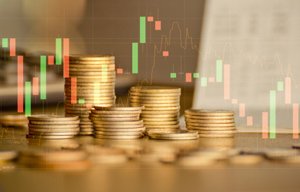
By May 2, traders and investors were digesting the previous day's Fed Open Market Committee statement and Fed Chair Jerome Powell's press conference. Powell's comments that current low inflation was "transitory," and economic prospects upbeat, caused markets to interpret that as lower odds of a Fed rate cut this year.
That day, the gold price bottomed at $1,270. And at that price, it was still only about 20% above its bear-market low in late 2015.
But that all changed on Monday. Every major index sank in the face of trade war rhetoric. It was a brutal sell-off - for everything but gold.
And for better perspective, here's how the Dow Jones Industrial Average has performed versus gold prices over the 30-day lead up to this past Monday.
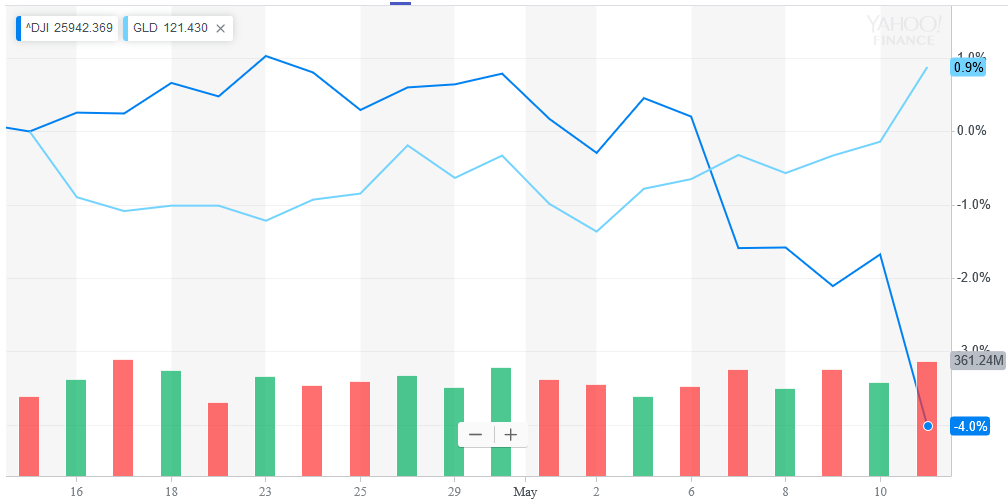
You can clearly see that when stocks zigged, gold zagged, which is exactly what it's meant to do.
As the trade wars continue, support for the dollar has remained somewhat robust.
Likewise, in the face of dollar pressure, gold prices have managed to maintain a sense of strength. As you can see in the chart below, the price of gold managed to put up a fight even when the U.S. dollar index hit a two-year high on April 24.
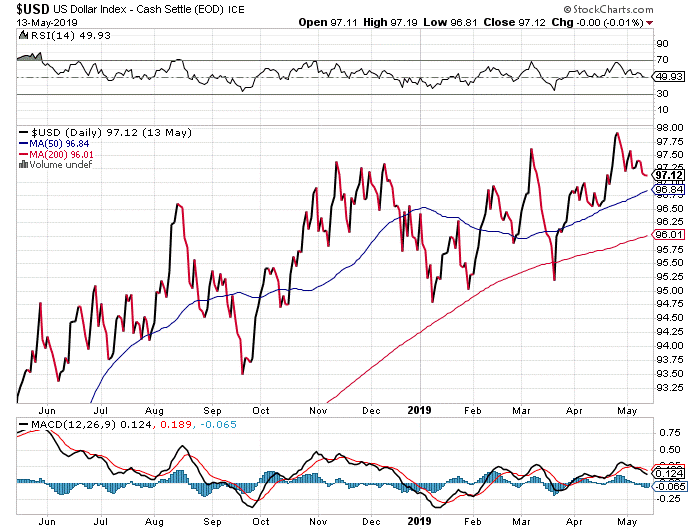
This kind of action is atypical when economic news is negative. Historically, when the dollar hit a two-year high for the first time in six months, it was usually unable to maintain that new high.
So far, at least, history has repeated itself. The U.S. Dollar Index (DXY) has retreated from its April 25 high of 98.20 to around 97.5 currently.
As for gold itself, the action has been uninspiring until very recently.
5G Is Coming: The tech breakthrough of the century could rest on this $6 stock - get all the details here.
The latest bounce back to $1,300 has pulled gold back above its 50-day moving average, which itself continues to hold well above the 200-day moving average.
Both the relative strength index (RSI) and moving average convergence divergence (MACD) momentum indicators have also begun trending upward since about mid-April, as you can see in the chart below.
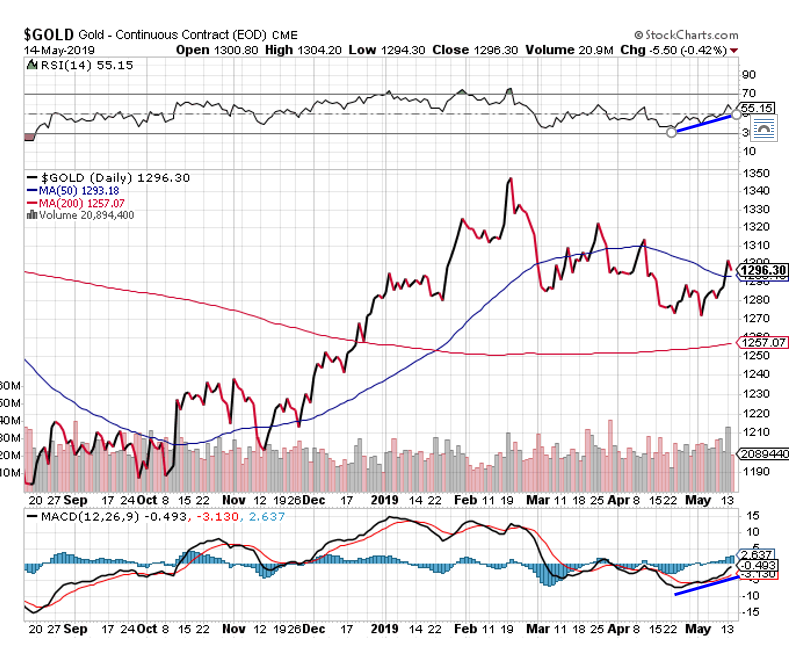
Gold stocks, on the other hand, leveraged gold's recent move lower:
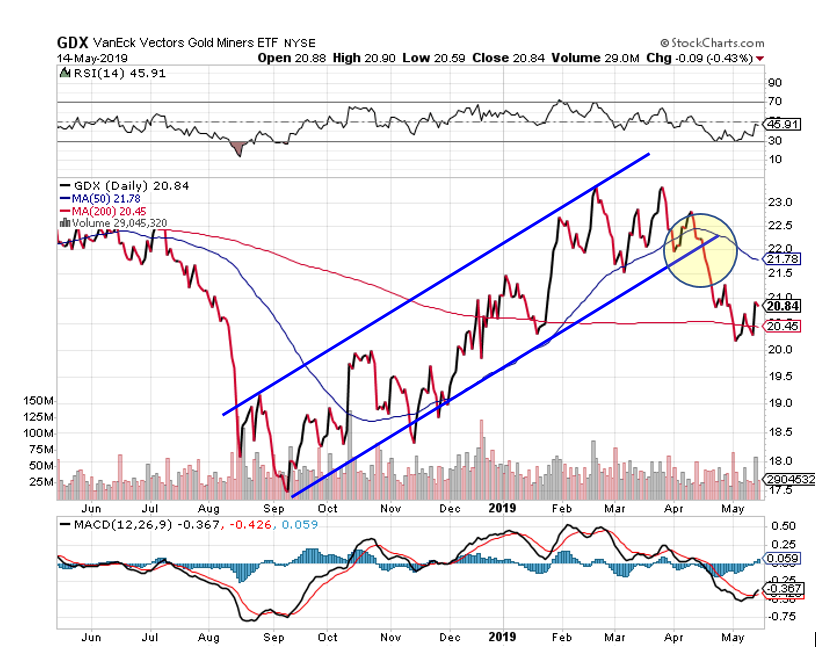
When the VanEck Vectors Gold Miners ETF (NYSE: GDX) fell in mid-April, it first mimicked gold's move and then headed a bit lower still.
So far, at least GDX has been able to hold up around its 200-day moving average, while the RSI has bounced from the 30 level. However, if gold weakens again, I would not be surprised to see GDX test the $18-$19 range.
Should that happen, it will likely make for a tremendous long-term buying opportunity.
And here's the proof that gold stocks leveraged gold's move lower, as the gold stocks to gold ratio also dropped:
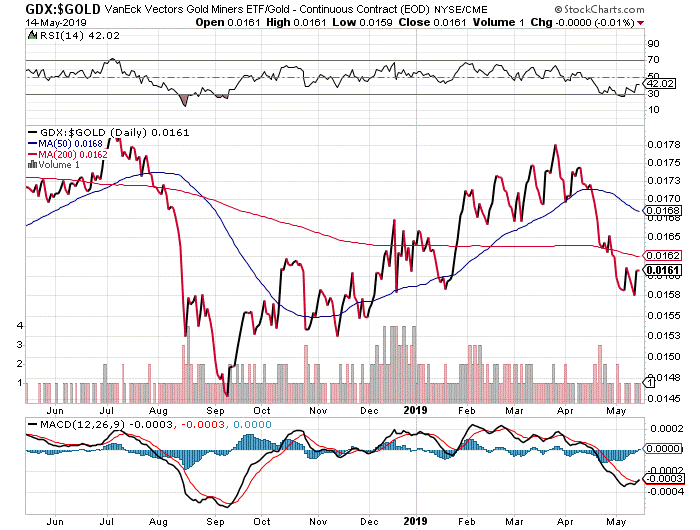
Still, one strong sign that gold stocks are close to bottoming is the Gold Miners Bullish Percent Index. Once the index drops below 30 and then reverses and closes back above 30, we'll have another indicator that it's time to buy gold stocks anew. See the chart:
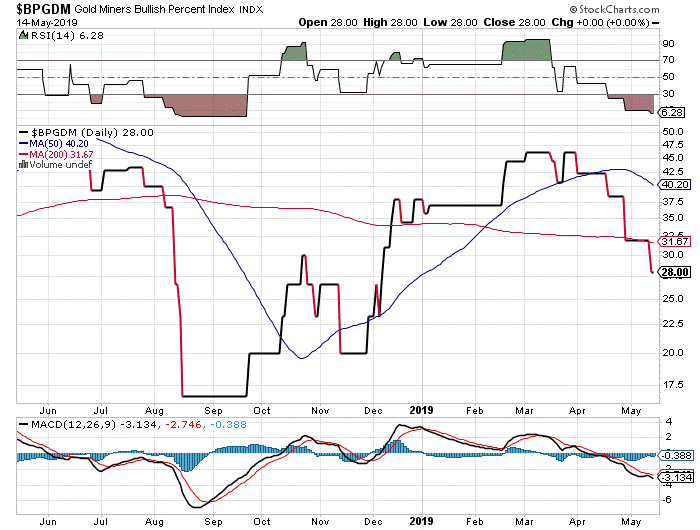
Finally, as you'd expect, my January gold picks have taken a hit.
The DB Gold Double Long Exchange Traded Notes (NYSE: DGP) are down about 19%, surprisingly unchanged from last month. Stay long DGP and/or buy on weakness.
The VanEck Vectors Junior Gold Miners ETF (NYSE: GDXJ) has retreated with gold's consolidation/correction and is now down about 5.6% since mid-January. Continue to buy on weakness.
Despite gold's recent price challenges, the precious metal's future is looking up for a lot of reasons.
But here are a couple that you many not realize.
One Key Gold Price Catalyst
[mmpazkzone name="in-story" network="9794" site="307044" id="137008" type="4"]
Gold just gained recognition as legitimate money once again. On April 1, the Bank for International Settlements (BIS), considered to be the central bank of central banks, put new regulations into effect.
It now recognizes that gold held by banks will have 0% risk weight, along with cash. So gold just got elevated to the safest asset rating possible.
The other reason gold's outlook is bright relates to how much of it central banks keep buying.
As you can see in the chart below, a subtle shift took place in 2010. That's when central banks became net buyers of gold. The simplest explanation is a growing desire to diversify their reserves away from the U.S. dollar, which has been their major asset.
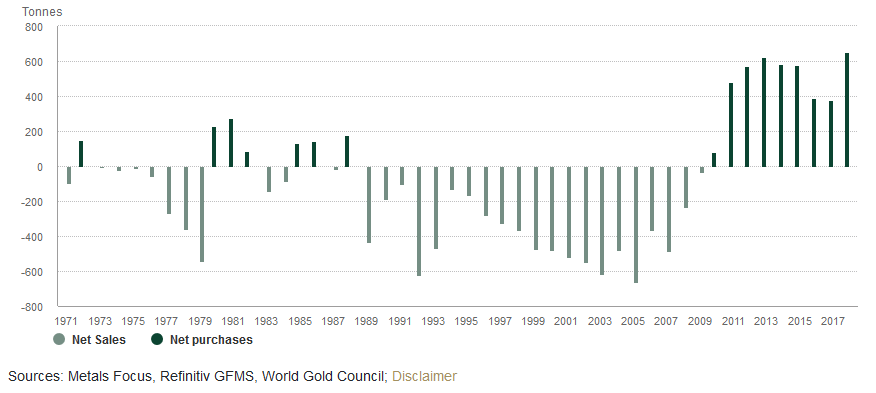
And the central banks that have been the most active in this regard are Eastern-based.
The following chart does not show exclusively central bank buying. Instead, it shows all imports from major Eastern economies. Nonetheless, the buying, especially from China and India, has been relentless.

We also know from the World Gold Council that 2019 has so far kept pace with 2018, which set a record for central bank gold purchases since 1971.
In the first quarter this year, central banks bought 145.5 tonnes of gold, the largest Q1 increase in global reserves since 2013. So, clearly, central banks are big buyers, and their appetite seems insatiable.
I'm still looking for gold to aim for $1,340, the high it reached back in February. I believe we can get there by mid-summer.
After that, the multi-year ceiling of $1,365 needs to be breached, and that could clear the path toward $1,400. I think we could see that milestone by year's end.
5G Is Coming: The Breakthrough of the Century Could Rest on This $6 Stock
CNBC reports that this opportunity is worth $12.3 trillion... and it's gearing up to make an appearance all over America.
In fact, some of these devices are showing up right in your neighborhood - and I'm willing to bet you didn't even notice.
Our Silicon Valley insider mapped out all the details in this report.


